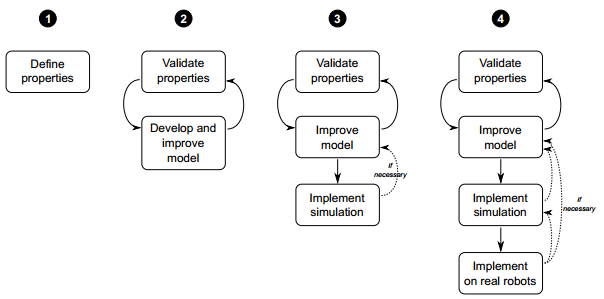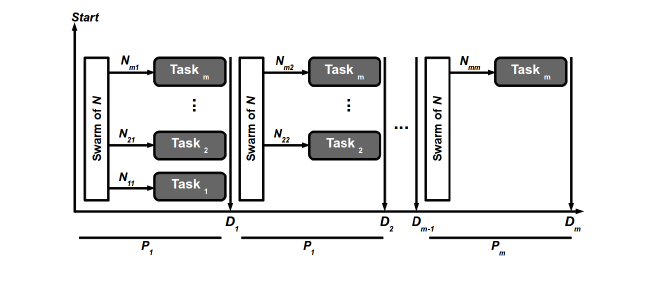Design
Property-driven design for swarm robotics
The idea behind property-driven design is that a swarm robotics system can be formally described through a series of properties. These properties are the distinguishing features of the system the developer wants to implement. They can be task-related, such as the probability that the system eventually completes a task X, or they can express more generic properties, such as the energy consumption or the efficiency of the swarm.
The first phase of property-driven design consists in formally specifying the requirements of the system by stating its desired properties. The clearer and more complete these properties are in this phase, the more the developed system will conform to the requirements.
In the second phase, a model of the system is created. In an iterative process, the developer expands and improves the model, and checks whether the properties are verified. The outcome of this process is a model of the system that satisfies the stated properties.
The model must be complete enough to capture all the important characteristics of the system, avoiding unnecessary complications. Eventually, through this process, a model that satisfies all the required properties is obtained.

- Property-driven design for swarm robotics
Brambilla M., Pinciroli C., Birattari M., Dorigo M. - In Proceedings of the 11th International Conference on Autonomous Agents and Multiagent Systems , Pages 139-146 , Volume 1, 2012
Automatic generation of robotics controllers
Currently, a fundamental open problem in the design of swarm robotics systems is bridging the gap between the desired collective properties of the swarm and the implementation of the individual behavior of each robot.
To fill this gap, two approaches have been proposed in the literature: the behavior-based
approach and the evolutionary approach.
In the behavior-based approach, the designer manually defines the behavior of the individual robots on the basis of the swarm level specifications. As a consequence, designing a system with the behavior-based approach is mostly a trial and error process and the quality of the result strongly depends on the experience and intuition of the designer.
In the evolutionary approach, on the other hand, the individual controllers are obtained through an automatic optimization process inspired by natural evolution. The quality of the result does not depend on the intuition of the designer but on his ability to define the objective function that is to be maximized by the optimization process. Unfortunately, the controllers obtained are black boxes that can hardly be analyzed, verified and maintained.
In our research we try to combine the advantages of the behavior-based approach with those of the evolutionary robotics approach by developing methods for the automatic design of controllers that yield modifiable and modular controllers.

Design of swarm robotics systems for tasks allocation in presence of soft-deadlines
We consider the problem of distributed task allocation in swarm robotics systems when the tasks are associated to (soft) time constraints. Basic estimators for the probability of completing a single task before its deadline are derived by using elementary considerations in case of robots assigning themselves to tasks independently.
In more general scenarios, closed-form estimators are difficult to derive. In these cases, we consider robotics controllers that mimic specific stochastic processes for which analytical or numerical techniques can be used to characterize time-related properties. The development of robotics swarms with associated performance guarantees is thus divided in two phases. In the first phase a relatively simple stochastic process capturing the desired dynamics is identified and studied. In a second time, the efforts are directed towards the construction of robotics controllers whose macroscopic behavior is as close as possible to the desired stochastic process. The robustness of the solution with respect to variations in the parameters is studied in order to understand the impact that random failures may have on the system.






